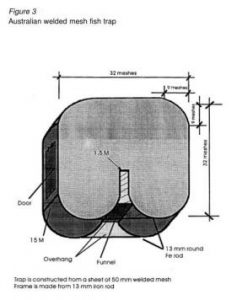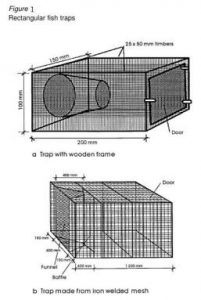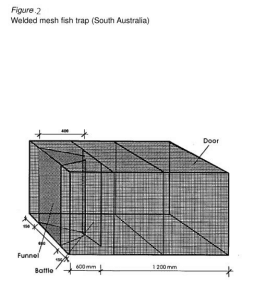Rectangular traps vary greatly in size and construction material, but modern traps are usually made from steel rod or welded mesh. Because of their tendency to roll, they are used in areas where the current flow is not great.
Rectangular trap frames of different sizes are made from dressed, rough or natural timber, including mangrove branches. Wooden traps are used to take snappers, sea bass and many other bottom-dwelling species in temperate and tropical waters.
Rectangular traps are very common throughout Australia and have been modified to fish in various conditions. They are typically constructed from mild steel and are covered with welded mesh, chicken wire, wire netting or nylon netting.
A typical wooden trap is about 2.0 x 1.5 x 1.0 m overall and constructed from 50 x 25 mm timber bolted together. Chicken wire is then stretched tightly over the frame, giving the trap further strength. It has a funnel placed at one or both ends, also made from chicken wire or from a frame covered with nylon netting. Heavy ballast is positioned in the bottom of the trap to sink it and to hold it on the bottom.
A rectangular trap often used in southern Australia is made from a single sheet of 50 x 50 mm welded mesh cut and bent into shape (Figure 2). The bait is tied or placed in a bait basket (or bait saver) in the centre of the trap. A baffle is often placed in front of the funnel to prevent fish from escaping back through it.
A modified rectangular trap made from a sheet of 50 x 50mm welded steel mesh has been developed in Australia. This trap is 32 x 32 meshes (i.e. 1.6 x 1.6 mm) square, with rounded corners. The sides and funnel are bent from a piece 15 meshes deep. The mesh is supported by a frame made from 13 mm round steel bar (Figure 3).



